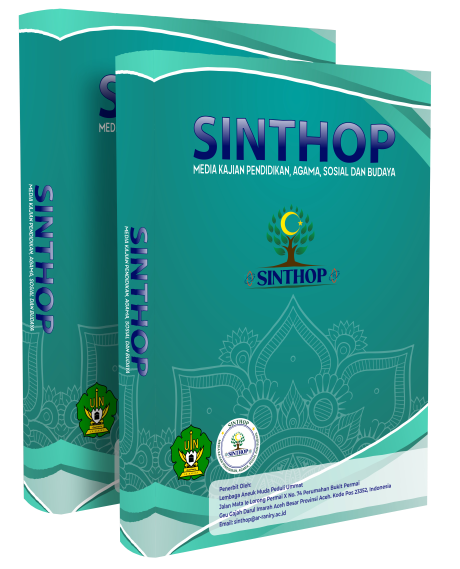Manifest, Latent, and Dysfunctional Roles of Tuha Peut in Family Conflict Resolution: A Case Study from Gampong Reudeup, Aceh, Indonesia
DOI:
https://doi.org/10.22373/sinthop.v3i2.7504Keywords:
Tuha Peut, family conflict, structural-functional theory, customary institution, AcehAbstract
This study investigates the role of Tuha Peut in resolving family conflicts in Gampong Reudeup, Panteraja Subdistrict, Pidie Jaya District, within the framework of Robert K. Merton’s structural-functional theory. As a customary institution at the village level, Tuha Peut is formally mandated to maintain social order through deliberation, mediation, and legal oversight. Using a qualitative case study approach, data were collected through participatory observation, in-depth interviews, and document analysis. Thematic analysis was conducted to identify the manifest, latent, and dysfunctional roles of Tuha Peut in conflict resolution. The findings reveal that Tuha Peut performs manifest functions as a mediator and decision-maker in resolving domestic disputes, while its latent functions include reinforcing communal values and informal cohesion mechanisms. However, the study also identifies structural dysfunctions, particularly related to gender representation. Several female informants expressed discomfort engaging with Tuha Peut directly, often relying instead on informal female figures such as Ibu Ros to mediate access. This phenomenon suggests a gap between formal institutional structures and the lived experiences of community members. The study concludes that while Tuha Peut contributes significantly to social stability, its legitimacy and effectiveness are contingent upon its capacity to evolve. Institutional reforms—especially gender inclusion and the recognition of informal mediators—are essential to ensuring that Tuha Peut fulfills not only its legal mandate but also its social responsibilities in an inclusive and representative manner.
References
Aceh, P. (2008). Qanun Aceh Nomor 9 Tahun 2008.
Azhari, R., Ramadhani, W., & Reza, F. (2023). Penguatan Lembaga Adat Tuha Peut dalam Penyelesaian Perselisihan Masyarakat Aceh. Indonesian Journal of Criminal Law and Criminology (IJCLC), 4(1), 40–47. https://doi.org/10.18196/ijclc.v4i1.17854
BPS. (2023). Kabupaten Pidie jaya Dalam Angka.
Creswell, J. W., & Poth, C. N. (2018). Qualitative inquiry and research design: Choosing among five approaches. Sage Publishing.
Farisni, T. N., Fitriani, Yarmaliza, & Indriasari, R. (2023). PENGANTAR TEORI PERAN TUHA PEUT DALAM IMPLEMENTASI QANUN DI TINGKAT DESA. EUREKA MEDIA AKSARA.
Indonesia, P. R. (2006). UU No 11 tahun 2006 (Vol. 13).
Jannah, N. (2023). Peran Tuha Peut Dalam Menyelesaikan Permasalahan Masyarakat ( Studi Di Gampong Baroh Musa Kecamatan Bandar Baru Kabupaten Pidie Jaya ). UIN Ar-Raniry.
Jaya, P. K. P. (n.d.). Qanun 2 Tahun 2018.
Kasnidar. (2018). Peran Tuha Peut dalam menyelesaikan Konflik di dalam Masyarakat (Studi di Kecamatan Kluet Utara Kabupaten Aceh Selatan). UIN Ar-Raniry.
Miles, M. B., & Huberman, A. M. (2012). Analisis Data Kualitatif: Buku Sumber Tentang Metode-Metode Baru. In Qualitative data analysis. Sage Publications.
Moleong, L. J. (2019). Metodologi penelitian kualitatif edisi revisi. In PT. Remaja Rosda Karya.
Reudeup, S. I. G. (2024). Sistem Informasi Gampong Reudeup. https://panterajareudeup.sigapaceh.id/grafik/informasi_kependudukan
Ritzer, G. (2005). Teori sosiologi modern (6th ed.). Prenada Media.
Ritzer, G. (2021). Sosiologi Ilmu Pengetahuan Berparadigma Ganda. Rajawali Press.
Siti Zalikha, & Apriani. (2021). Peran Tuha Peut Gampong sebagai Mediator dalam Penyelesaian Sengketa Harta Warisan. Jurnal Al-Mizan, 8(2), 157–169. https://doi.org/10.54621/jiam.v8i2.146
Sugiyono. (2017). Metode Penelitian Kuantitatif dan Kualitatif. alfabeta.
Suyanto, J Dwi Narwoko, B. (Ed.). (2019). Sosiologi Teks Pengantar Dan Terapan. PRENAMEDIA GROUP.
Wirawan, I. B. (2012). Teori-teori Sosial dalam Tiga Paradigma: fakta sosial, definisi sosial, dan perilaku sosial. PRENAMEDIA GROUP.
Downloads
Published
How to Cite
Issue
Section
License
Copyright (c) 2024 Firdaus Mirza Nusuary, Zikriah Zikriah

This work is licensed under a Creative Commons Attribution-ShareAlike 4.0 International License.
Authors who publish in SINTHOP: Media Kajian Agama, Sosial dan Budaya agree to the following terms:
- Authors retain copyright and grant the journal right of first publication with the work simultaneously licensed Attribution-ShareAlike 4.0 International (CC BY-SA 4.0) that allows others to share the work with an acknowledgment of the work's authorship and initial publication in this journal.
- Authors are able to enter into separate, additional contractual arrangements for the non-exclusive distribution of the journal's published version of the work (e.g., post it to an institutional repository or publish it in a book), with an acknowledgment of its initial publication in this journal.
- Authors are permitted and encouraged to post their work online (e.g., in institutional repositories or on their website) prior to and during the submission process, as it can lead to productive exchanges, as well as earlier and greater citation of published work. (See The Effect of Open Acces)









.png)

.png)
.png)
.png)


